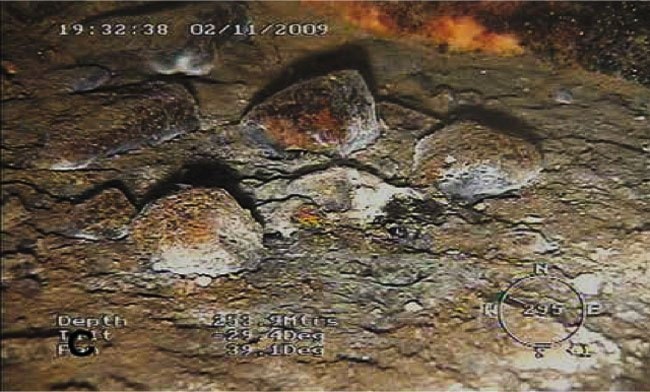Normally, you wouldn’t expect the Beaufort Sea to be a hotbed of volcanic action. It’s covered with ice for much of the year. And during the short spell when the ice is gone, it’s a vast expanse of cold, featureless ocean that washes up on the northern coasts of Alaska, the Yukon and the western Northwest Territories.
But beneath that bland surface, the Beaufort holds a surprise - as many as 2,000 mud volcanoes, deep underwater. Steve Blasco, a geologist recently retired from the Geological Survey of Canada, talked about the volcanoes at the Annual Science Meeting of the research network, ArcticNet, in Vancouver in December.
Mud volcanoes are essentially like any other volcano, but with mud instead of lava, Blasco said. Pressure forces liquid mud up through the first available weak spot in the more solid layer above it. In the case of the Beaufort mud volcanoes, that solid layer is under the seafloor, several hundred metres below the ocean surface.
Just because they’re out of sight beneath the waves doesn’t mean mud volcanoes are small. Some are more than a kilometre across and rise 10 storeys above the surrounding seafloor. Most have a shallow moat around them. Blasco said that with the right kind of instrumentation, it’s possible to track the chimneys, through which the mud flows, well down into the thick layer of sediment that covers much of the Beaufort seabed.
The Beaufort’s mud volcanoes are a peculiarly northern phenomenon, he said. “It all has to do with the permafrost.”
Fluids - water and hydrocarbons mixed with fine sediments - pool beneath the permafrost that underlies the land and much of the sea around the margin of the Beaufort. The fluids spread through the sub-permafrost layers until they come to a weak point where the growing pressure pushes them up through the permafrost, piling up layer upon layer of thin mud into a spreading undersea mountain.
The mud volcanoes aren’t distributed randomly over the seafloor, Blasco said. The weak spot that allows the mud to break through is often at the edge of the continental shelf, where the relatively shallow sea bottom drops away into the deep ocean, exposing and weakening the permafrost. About a third of the mud volcanoes mapped so far are along the shelf edge, Blasco says. Others are on the shelf itself or along the edges of the Mackenzie Trough, an undersea extension of the Mackenzie Valley.
Most of the volcanoes are no longer active, but about 50 of them still appear to be venting mud. On a few of those, Blasco’s group saw signs of life: mats of bacteria apparently living off the chemicals in the mud.
Recently, another team of ArcticNet scientists discovered even more signs of life. In December, Charles Paull of the Monterey Bay Aquarium Research Institute, Scott Dallimore of the Geological Survey of Canada and other members of the team published a scientific article describing what they found in a close study of a few of the still-active mud volcanoes.
Some of the sediment the scientists hauled up from the mud volcanoes contained skinny brown tube worms only a few centimetres long at most. The worms are closely related to tube worms found at a mud volcano in the Norwegian Arctic, the authors wrote. In both cases, the worms and the bacteria appear to be part of a chemosynthetic community - that is, a community of animals living off the carbon spewed out, usually in the form of methane, from volcanic vents.
Similar groups of animals have been found around undersea vents in many parts of the world, but this is the first time they’ve been discovered in the harsh conditions of the western Arctic. And there may be more life down there.
Video from a remotely operated underwater vehicle used in the same study showed that patches of the active undersea volcanoes are thick with bacteria and tube worms, and that shrimp and small fish seem to be especially plentiful at those sites. In fact, it appears that the Beaufort Sea’s mud volcanoes might be hotspots for both geology and biology.
The original purpose of the survey that mapped the volcanoes was to assess geohazards in the Beaufort Sea in preparation for oil and gas exploration. Mountains of mud rising from the ocean floor constitute potential hazards, but Blasco said they’re easy to avoid. Now that it’s known where they’re likely to occur and what they look like to underwater remote sensing instruments, exploration companies survey them and stay clear.
Of course, not everyone wants to stay clear. Oil and gas companies might want to avoid the mud volcanoes, but plenty of scientists would like to learn a lot more about them.
Claire Eamer moved to the Yukon in 1984 for a couple of years and finally got around to moving south (to Gabriola Island, B.C.) in 2015. Her latest book for kids, Before the World Was Ready: Stories of Daring Genius in Science, won the Lane Anderson Award for Young Readers, given for Canadian science writing.
